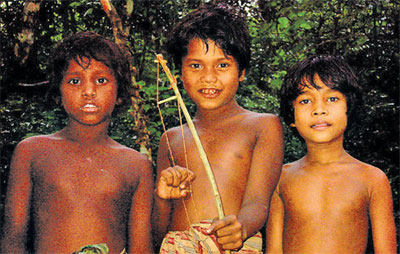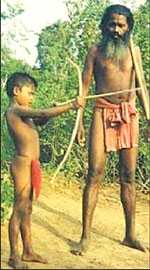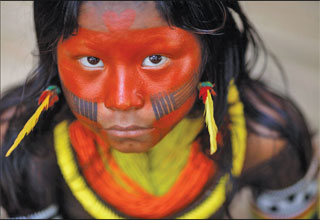Variety
Preserving the rights of indigenous people
You must have often heard the term indigenous people being used by
adults and wondered whether they were referring to a particular race
that belongs to some nation. The answer is No. Indigenous people are
found in various parts of the world. It is estimated that there are more
than 370 million indigenous people spread across 70 countries worldwide.
|

Three Aadivasi children |
They are found across the world from the Arctic to the South Pacific.
According to a common definition, they are the descendants of those who
inhabited a country or a geographical region at the time when people of
different cultures or ethnic origins arrived.
The new arrivals later became dominant through conquest, occupation,
settlement or other means.
There are indigenous people in Sri Lanka too and most of you must
have visited the aadivasi people or the Vanniyela aththo as they are now
popularly called even though many still refer to them as the Veddhas in
Mahiyangana .
Just like all the other indigenous people of the world, the
indigenous people of our country too have many social and cultural
issues that need to be looked into in order to ensure their continuity
in the modern world.
|

An Aadivasi child learning
hunting skills. |
Even though it is sometimes argued that it is important for the human
species as a whole to preserve a wide range of cultural diversity as far
as possible, and that the protection of indigenous cultures is vital to
this enterprise the world's indigenous people are struggling for their
survival and in some instances are virtually a forgotten tribe.
Today they are confronted with a diverse range of concerns connected
with their status and interaction with other cultural groups, as well as
changes in their inhabited environment.
Some challenges are specific to particular groups while others are
commonly experienced.
Their human rights continue to be abused in several countries . Some
of the major issues confronting them today include cultural and
linguistic preservation, land rights, ownership and exploitation of
natural resources, political determination and autonomy, environmental
degradation and incursion, poverty, health and discrimination.
Last week, August 9, was a day of great significance to the
indigenous people around the globe because it was the International Day
of the World's Indigenous People. It was the date o f the first meeting
in 1982 of the United Nations Working Group of Indigenous Populations of
the Subcommission on Prevention of Discrimination and Protection of
Minorities of the Commission on Human Rights.
The UN General Assembly decided on December 23 1994 that the
International Day of the World's Indigenous People should be observed on
August 9 every year during the International Decade of the World's
Indigenous People (resolution 49/214).
Thereafter, on December 20 ,2004, the General Assembly decided to
continue observing the International Day of Indigenous People every year
during the Second International Decade of the World's Indigenous People
(2005-2014).
What is your view of the need to preserve and protect the rights of
the indigenous people of the world, especially those living in our own
country? Learn as much as you can about the diverse issues they face due
to modernisation and colonisation.
See how best we can help them to intergrate with the rest of the
modern world while preserving their own identity as a unique people.
There is so much that they too can contribute to enrich our heritage so
let their voices too be heard and not be lost in the wildnerness.
As we have explained there are a number of indigenous people around
the world and here are some of the well known and not so popular tribes.
The Bahnar (also spelled Ba Na) an ethnic group of Vietnam living
primarily in the Central Highland provinces of Gia Lai and Kon Tum, as
well as the coastal provinces of Bình Djnh and Phú Yên. They speak a
language in the Mon-Khmer language family. The Batak are one of about 70
indigenous peoples of the Philippines.
|

An indigenous child from the Kayapo tribe. |
They are located in the northeastern portions of Palawan, a
relatively large island in the southwest of the archipelago, the
indigenous peoples of the Americas (for example, the Lakota in the USA,
the Mayas in Guatemala or the Aymaras in Bolivia), the Inuit and
Aleutians of the circumpolar region, the Saami of northern Europe, the
Aborigines and Torres Strait Islanders of Australia and the Maori of New
Zealand. These and most other indigenous peoples have retained distinct
characteristics which are clearly different from those of other segments
of the national populations.
Practising unique traditions, they retain social, cultural, economic
and political characteristics that are distinct from those of the
dominant societies in which they live. |

